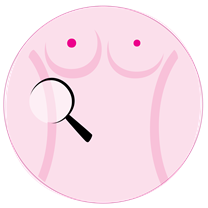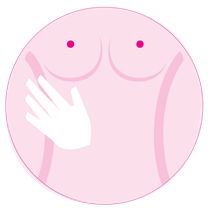Women of all ages should be familiar with the normal look and feel of their breasts. Early detection of breast cancer improves the chance of diagnosing breast cancer early, which means a better chance of survival. In addition to breast self-examination, breast cancer screening methods include clinical breast exam (a physical exam done by a health care provider), mammogram and ultrasound scan. Click here for more information. If you have any concerns, always consult your doctor and see if any screening methods are recommended. Here are 3 steps to self-examine your breasts. If you notice any of the following changes, please see your doctor immediately.

LOOK FOR
In front of the mirror, raise your hands above your head and observe if any of the below changes occur. Next, place your hands on your hips and press down firmly to tighten the chest muscles beneath your breasts. Inspect this area for any abnormalities.
- Changes in your breasts which are not normal for you; something different that you haven't seen before.
- Changes to the nipple. (This includes a change in shape, crusting, a sore or an ulcer, redness or inversion of the nipple.)
- Discharge from the nipple. (Particularly if this is from one nipple and if it is blood-stained or occurs without squeezing.)
FEEL FOR
You can feel for changes when lying down or during a shower. Raise your right hand above your head. Use the pads of the middle three fingers of the left hand to examine the breast on the right side. Move fingers in dime-sized circles from the armpit area to the side of the breast, and to the nipple. Then check the other side using the same technique. Feel for:
- A lump, lumpiness or thickening in the breast. For younger women: if this is not related to your normal monthly cycle and remains after your period. For women of all ages: if this is a new change in one breast only.
- Persistent, unusual pain. (If this is not related to your normal monthly cycle, remains after your period and occurs in one breast only.)

COMPARE
- The shape or size of your breast with your last check. (This could be either an increase or a decrease in size.)
- Your left breast and nipple with your right breast and nipple, to spot any unusual differences.



